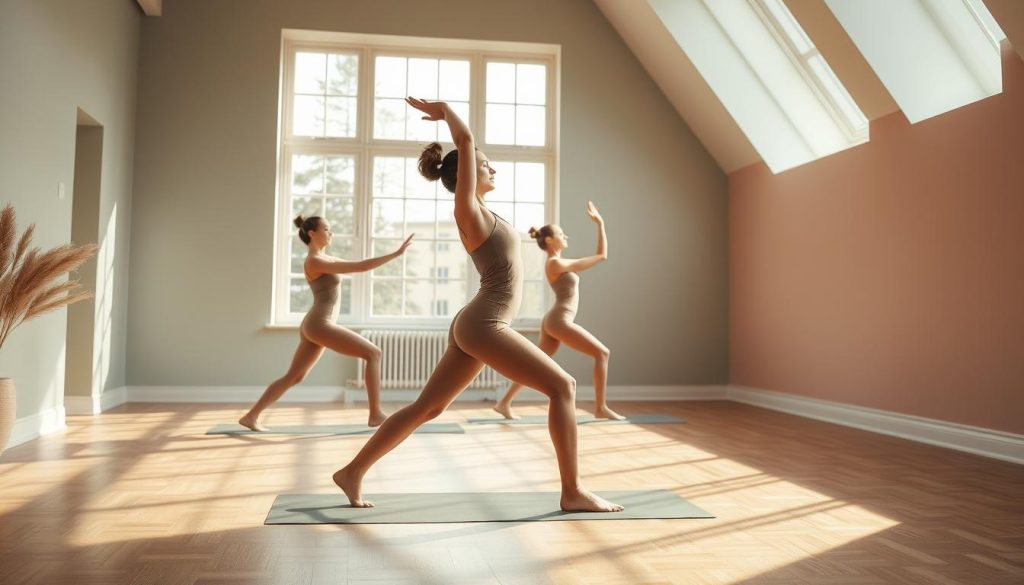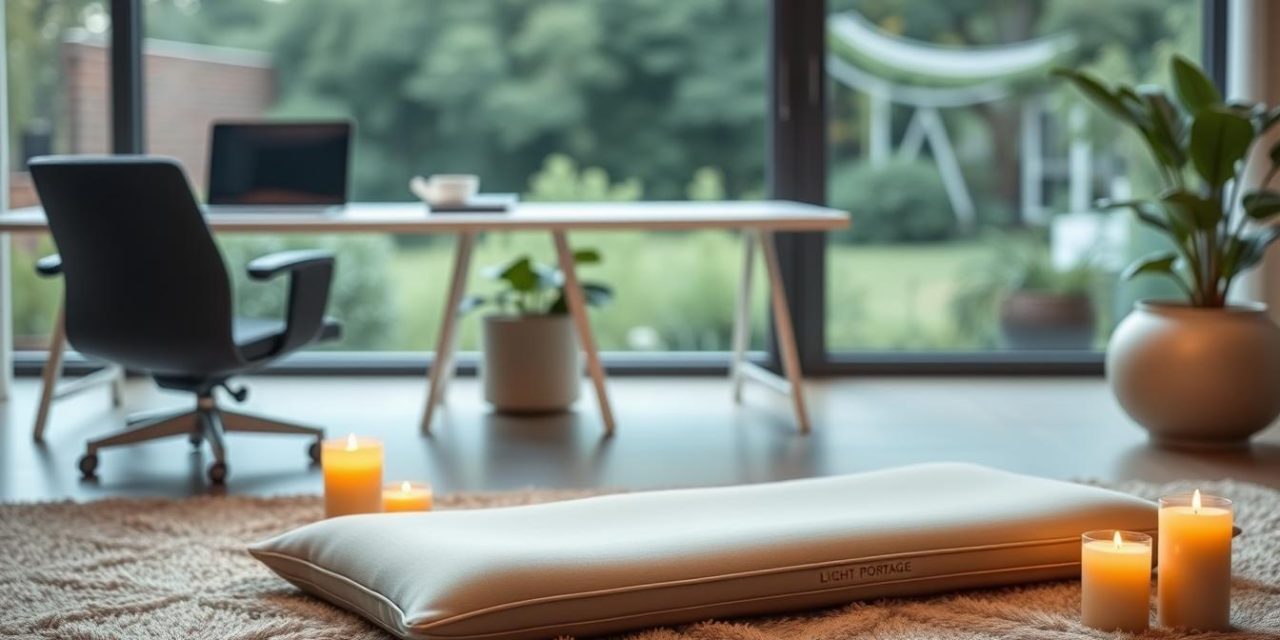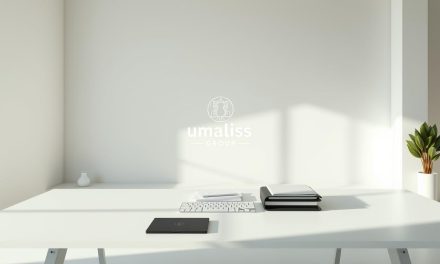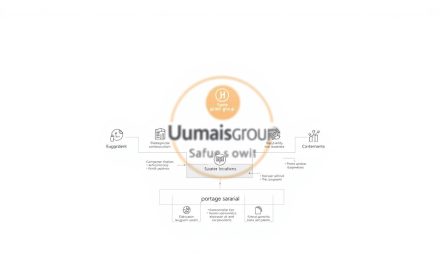We once sat across from a freelance consultant who closed her laptop at noon and took three deliberate breaths before every client call. She said it changed her day: meetings felt shorter, decisions clearer, and sleep improved.
That simple habit taps the measurable relaxation response — a deep-rest state that slows breathing and heart rate, lowers blood pressure, and restores balance. In this article, we outline practical tools you can use during a busy workday to manage stress and protect your long-term health and mental health.
We show which techniques fit quick resets versus deeper practice, from breathing and short body scans to mindful movement like yoga or tai chi. You’ll learn how attention and simple cues help regain focus in moments of pressure and how small daily practice—10–20 minutes—compounds into better sleep, mood, and resilience.
Table of Contents
Key Takeaways
- Triggering the relaxation response can reduce stress and sharpen focus fast.
- Short, regular practice protects both physical health and mental health.
- Choose discreet tools for meetings and longer routines for evening wind-downs.
- Breathing and attention-based cues are easy to remember under pressure.
- Personalize practice until it feels sustainable for your workday.
Understand Stress vs. the Relaxation Response at Work
At work, the body shifts into a quick-response mode that prioritizes survival over focus. This is the fight-or-flight reaction: heart rate rises, breathing speeds, and muscles tighten to prepare for action.
What happens in fight-or-flight:
- Heart rate increases and blood moves rapidly to major muscles.
- Blood pressure climbs as vessels constrict.
- Breathing becomes shallow; attention narrows and decisions grow harder.
- Sweating, shaking, and jaw or shoulder tension are common warning signs.
How the physiological response is restored:
The relaxation response works like a brake pedal. It slows breathing, reduces heart rate, and lowers blood pressure so the mind steadies and muscles release. You can trigger this response with a short breathing exercise or a brief meditation when early cues appear.
« Think of stress as speeding; well-timed practices put on the brakes so you can choose your next move. »
| Work Trigger | Typical Body Reaction | Quick Intervention |
|---|---|---|
| Deadline pressure | Racing heart, shallow breath, tight shoulders | 60–90 sec paced breathing |
| Public speaking | Sweating, trembling, narrowed attention | One centering breath before starting |
| Conflict with colleague | Clenched jaw, tense muscles, rising blood pressure | Short body scan or progressive muscle release |
| Back-to-back meetings | Persistent muscle tension and reduced cognitive flexibility | Micro-breaks: 60–120 sec between sessions |
Why this matters for your health: Regularly applying these techniques lowers baseline anxiety and improves long-term markers tied to heart and overall health. Small, consistent practices help your body return to equilibrium more quickly when stress arises.
Quick-Start Breathing Techniques You Can Use in the Moment
When pressure mounts, a brief, focused breath can reset your nervous system in under two minutes. Use these fast, portable methods to reduce stress and regain clarity at work.
Slow nasal inhale, longer mouth exhale (3-6 or 4-6 cadence)
How to do it: Inhale quietly through the nose for 3–4 seconds. Exhale through the mouth for 6 seconds. Repeat 6–10 cycles to calm the system.
Hand-on-belly cueing and straw exhale
Place one hand on the chest and the other on the belly. Let the abdomen rise on the inhale so the diaphragm does the work. Pursed lips or an imagined straw slows airflow and lowers heart rate and blood pressure.
Micro-break protocol: 60–120 seconds between tasks
Take short breaks of paced breathing between items. Even 60–120 seconds clears mental residue, releases muscle tension, and helps the body reset for the next moment of pressure.
- Keep your eyes soft or close them briefly for one breath.
- Ground your feet, lengthen the spine, and sync posture with breath.
- Count breaths or set a 2-minute timer to build consistency.
Progressive Muscle Relaxation and Body Scan for Tension Relief
A short, focused scan from toes to face can quickly reveal where you store stress in your body. Progressive muscle relaxation trains you to feel the contrast between tension and ease. Start seated or lying down, and close eyes if that helps you focus.
Step-by-step PMR: from toes to face to release tight muscles
Begin at the feet and work upward: calves, thighs, hips, abdomen, chest, back, hands, arms, neck, jaw, and face.
For each part, gently tense the target muscles for 5–10 seconds, then release and notice the change. Use a slow inhale before the tense phase and a longer exhale as you let go. A light hand on the belly helps support diaphragmatic breathing.
Body scan meditation: nonjudgmental attention across the body
When tensing is not appropriate, run a mindful body scan. Move attention through each part and label sensations—warm, tight, pulsing, or neutral—without trying to fix them. Simply noticing often reduces tension and bodily pain.
Safety notes for PMR if you have back issues or spasms
If you have back problems, spasms, or injuries, reduce intensity or skip contraction in sensitive areas. Favor a passive body scan when needed and consult your doctor before starting a new PMR routine.
| Practice | Duration | Target Areas | When to Use |
|---|---|---|---|
| Full PMR | 5–10 minutes | Feet to face | After work or during a long break |
| Mini PMR | 60–120 seconds | Hands, shoulders, face | At your desk between tasks |
| Body scan | 5–10 minutes | Whole body, non-contractive | If you have injuries or need gentle practice |
| Breath-coupled PMR | 3–7 minutes | Focus areas only | When stress spikes or pain flares |
Visualization and Transformations to Shift Thoughts and Emotions
A brief guided image, rich with sound and texture, can shift emotional tone within a single minute. Use this practice to move from escalation to steady attention when stress emerges.
Begin by choosing a place—a beach, a forest, or a favorite retreat. Close your eyes briefly and name what you see.
Build the scene with the five senses: sight of the horizon, the sound of waves, the scent of pine, the touch of warm sand on your feet and toes, even the taste of fresh air. Let one detail anchor your attention.
Use simple transformations
Shift difficult thoughts and emotions by imagining them as a tight knot that slowly loosens. Or picture a clenched fist opening into an open hand. These images reframe inner tension and support a calming physiological response.
- Practice for 2–5 minutes to quiet intrusive thoughts.
- If the mind wanders, return to one sensory cue without judgment.
- Pair imagery with slow breathing: exhale tension, inhale ease.
| Use Case | Duration | Main Anchor |
|---|---|---|
| Micro-reset between calls | 30–60 seconds | Single image (open hand) |
| Short calm practice | 2–5 minutes | Full sensory scene (beach or forest) |
| Public or busy setting | One breath, one image | Quiet detail (rhythm of water at your feet) |
Effects such as heaviness, yawning, or brief twitches are normal signs the nervous system is releasing activation. If you want a quick cue, keep a short description in your notes app—this helps you access the image fast during a high-pressure moment.
Tip: To make it habitual, we recommend you build your calm place note and review it before busy work blocks. Over time, the brain links the scene to rapid downshifts, increasing effectiveness.
Mindfulness, Meditation, and Attention Training for Focus
Cultivating present-moment awareness helps you interrupt worry before it grows. Practice noticing sensations, thoughts, and emotions without judgment. This reduces anxiety and quiets rumination in demanding moments.
Present-moment awareness to reduce intrusive thoughts
Pay attention on purpose to the here and now. Label when the mind wanders—say silently “thinking”—and return to your anchor. Each return trains attention like a muscle and improves sustained focus.
Breath-anchored meditation and mindful walking between meetings
For a short sit, close eyes if you like and follow the inhale and exhale for 5–10 minutes. If you prefer movement, walk slowly and feel each foot strike. Sync steps to your breathing to arrive composed at your next task.
Gratitude and positive affirmations to rebalance mood
Keep a quick note of three specific things you appreciate. Use a brief affirmation—“I can take this one step at a time”—to shift tone and steady your inner dialogue during high-load periods.
| Practice | Duration | Main Benefit |
|---|---|---|
| Breath-anchored meditation | 5–10 min | Improved focus and lower stress |
| Mindful walking | 1–3 min | Fast reset between meetings |
| Gratitude notes + affirmation | 1–2 min | Better mood and resilience |
Tip: Schedule a 5-minute morning sit and a 2-minute afternoon reset. Consistency matters more than length. Small, steady practice improves cognitive flexibility and supports long-term health and a calmer work response.
Rhythmic Movement, Yoga, and Tai Chi for Whole-Body Relaxation

Coordinating breath with simple movement is an effective way to lower stress and support overall health. Gentle, rhythmic exercise such as walking, swimming, rowing, or dancing calms the nervous system when you match pace with breathing.
Flow activities to ease tension
Short, regular sessions of flowing movement trigger a calming response in the body. Even a 10-minute walk between meetings reduces physiological arousal and clears the mind.
Yoga for beginners
Hatha and Satyananda emphasize gentle poses, slow breath, and guided relaxation. These options suit people new to practice and help reduce stress and posture-related pain.
Tai chi: low-impact and accessible
Tai chi uses slow sequences synchronized with breath. It improves balance, aids mental health, and benefits heart rate regulation without strain.
| Practice | Duration | Main benefit | Good for |
|---|---|---|---|
| Walking / Dancing | 10–30 min | Steady cadence, mood lift | Busy schedules |
| Hatha / Satyananda | 15–45 min | Breath-led calm, posture relief | Beginners, pain management |
| Tai chi | 10–30 min | Balance, low-impact calm | All ages, recovery |
| Swimming / Rowing | 15–40 min | Full-body rhythm, heart support | Joint-friendly |
Tip: Favor consistency over intensity. Small, frequent movement sessions build lasting positive effects on mood, focus, and physical well-being.
relaxation strategies for busy workdays: a practical playbook
Practical pauses woven into your workday make calm accessible when minutes feel scarce. Use short, repeatable tools so you protect focus and clear tension without losing time.
Two-minute resets: breathing, mini-PMR, and eye-closer moments
Use 60–120 seconds for a quick reset: take 6–10 slow breaths, perform a mini-PMR on hands and shoulders, then close your eyes for one breath to regain attention.
Desk-to-doorway transitions: mindful steps and posture check
Before you stand, place one hand on the belly, stand tall, relax the shoulders, and take three mindful steps. Check posture and breathing before the next task to prevent carryover tension in the body and muscles.
Meeting buffers: visualization and intention-setting
Add a 2–3 minute buffer before and after key meetings. Run a quick image of your calm place, set a single intention (for example, “listen first”), then return to work with clearer focus.
End-of-day decompression: body scan and journaling
Closing the day with a short body scan and two lines of journal notes—what the body felt, what went well—reduces lingering activation and supports better sleep.
- Set a 90-second timer when urgency peaks for paced breathing.
- During email sprints pause each 25 minutes for one mindful breath and a shoulder release.
- Keep a cue card with three go-to techniques; simple tactile cues (touching thumb to finger) speed recall.
| Use | Duration | Main Benefit | Quick How-to |
|---|---|---|---|
| Two-minute reset | 60–120 seconds | Fast downshift of stress | 6–10 slow breaths + mini-PMR hands/shoulders |
| Doorway transition | 10–20 seconds | Posture and focus check | Stand tall, 3 mindful steps, hand on belly |
| Meeting buffer | 2–3 minutes | Aligned presence | Visualization + single intention |
| End-of-day | 5 minutes | Clear residual activation | Short body scan + journaling |
Daily Routine, Sleep, and Lifestyle Habits that Support Relaxation

A steady, short practice each day builds resilience for demanding hours. Set aside 10–20 minutes daily to train breathing, body scans, or a guided mindfulness sit. This small investment compounds and improves both physical health and mental health over time.
Guard sleep with simple hygiene: pick a stable bedtime, dim screens an hour before bed, and use a short breathing or body-scan routine to close the day. Moderate caffeine to avoid jittery arousal, and avoid using alcohol as a way to unwind—alcohol harms sleep and recovery.
Nutrition and hydration matter. Favor balanced meals, steady water intake, and foods rich in omega-3/6 to help the body handle stress. Light exercise most days boosts mood and speeds recovery; even a 10-minute walk can help when workload peaks.
Practical habits to weave into your day
- Schedule 10–20 minutes per day for structured practice; consistency is the most reliable way to strengthen your calm baseline.
- Use small mindfulness touches: the first sip of coffee, the start of a commute, or a midday pause to anchor attention and breathing.
- Seek social support: short walks with a colleague or a check-in with a friend combines movement and human connection to reduce stress.
- Note patterns: map when during the day you need extra help and plan a brief visualization or breathing set at that place and time.
| Habit | Daily Time | Main Benefit | Quick Tip |
|---|---|---|---|
| Structured practice | 10–20 minutes | Improves baseline response to stress | Same time each day for habit |
| Sleep hygiene | 30–60 minutes pre-sleep | Better mood and recovery | Dim lights, short body scan |
| Caffeine & alcohol management | Throughout day | Stable arousal, improved sleep | Limit caffeine after noon; avoid alcohol to unwind |
| Hydration & nutrition | Meals + sips | Supports physical health and lowers pain | Include omega-3/6, drink water regularly |
Tip: If you want practical planning help, see our short guide on work-life balance for ways to schedule these habits into a busy professional routine.
Tracking Progress, Tools, and When to Seek Extra Help
Small data — timers, logs and app reports — make it easy to see what truly eases daily strain. Use simple tracking to link a technique to real changes in tension, sleep, mood, and energy.
Tools to keep your attention on practice: Pair one or two preferred techniques with a timer or audio guide. Apps for guided meditation, paced breathing, and progressive muscle relaxation provide reminders and measurable sessions. Bookmarks or playlists speed access when pressure rises.
Log symptoms and patterns
Create a brief daily log. Note areas of muscle tension, pain, emotion, and energy after practice. Use short tags such as “AM breath,” “pre-call visualization,” or “PMR shoulders” to connect context with effect.
When to consult a clinician
If stress or persistent symptoms interfere with work, sleep, or relationships, seek a medical or mental health evaluation. Early support can prevent escalation to anxiety or depression.
Clinical cues: intrusive thoughts, unrelenting muscle guarding, or rising blood pressure despite practice. In those cases, combine regular guided meditation and progressive muscle relaxation with professional care.
- Choose 1–2 techniques and use timers or audio guides for consistency.
- Review weekly to see which practices give the best relief and when.
- Measure success by how quickly you can shift state, not by perfection.
| Focus | Tool | What to track | When to consult |
|---|---|---|---|
| Breathing practice | Pacer app or audio | Heart rate, calm onset time, perceived pressure | Persistent high BP or no improvement |
| Progressive muscle relaxation | PMR script download | Muscle tension areas, pain levels, sleep quality | Ongoing muscle guarding or pain flare-ups |
| Visualization / meditation | Guided meditations | Mood, intrusive thoughts, ability to focus | Increasing intrusive thoughts or mood decline |
| Movement / exercise | Short guided routines | Energy, soreness, stress reduction effects | Decline in daily function despite exercise |
Conclusion
Make calm a practical habit by picking one simple practice you can use at predictable times each day. Start with paced breathing, a short meditation, or a two-minute body scan. Use apps or a timer to make the habit reliable.
Regular practice of breathing, progressive muscle relaxation, visualization, and mindful movement trains the nervous system to trigger the relaxation response faster. This helps your body and mind handle stress, shift thoughts and emotions, and return to work with clarity.
Take one step now: save this playbook, choose your first technique, and take a calm breath. If pressure persists, seek professional support to align tools with your context.
FAQ
What is the difference between the fight-or-flight response and the relaxation response?
The fight-or-flight response activates the sympathetic nervous system, raising heart rate, blood pressure, and muscle tension so you can react quickly. The relaxation response is the opposite: it lowers heart rate and blood pressure, reduces muscle tightness, and calms anxious thoughts. Eliciting this response with breathing, mindfulness, or progressive muscle work restores balance in both body and mind.
How can I lower my heart rate and blood pressure quickly at my desk?
Use a simple breathing cadence—slow nasal inhale and longer mouth exhale (for example 3–6 or 4–6 seconds). Pair this with a hand-on-belly cue to feel diaphragmatic movement. A 60–120 second micro-break of focused breathing will lower heart rate and help reduce blood pressure spikes caused by acute stress.
What is progressive muscle relaxation (PMR) and how do I do it?
PMR is a structured method to tense and then release muscle groups from toes to face. Tense each part for about 5–10 seconds, then release for 20–30 seconds while noticing the difference. This step-by-step approach reduces physical tension and eases mental strain.
Are there safety concerns with PMR if I have back pain or spasms?
Yes. If you have back issues or frequent muscle spasms, modify PMR by avoiding positions that strain the spine and focus on gentle tensing or simply practicing the release phase. Consult a physician or physical therapist before starting intensive muscle exercises.
What quick techniques work in the moment to reduce anxiety or intrusive thoughts?
Use breath-anchored meditation, a two-minute reset, or a micro body scan. Anchor attention to the breath or to sensations in the hands and feet. Short visualization—imagining a calm place with vivid sensory details—also shifts thoughts and lowers emotional intensity.
How can guided imagery help me handle stress at work?
Guided imagery engages all five senses to transport your attention away from stressors—visualizing a beach or forest, noticing sounds, scents, and textures. This mental rehearsal changes emotional tone, reduces muscle tension, and supports clearer decision-making.
Which movement practices best support whole-body regulation?
Rhythmic activities like walking, swimming, rowing, or gentle dance ease stress through steady breath and motion. Yoga (Hatha, Satyananda) and tai chi offer low-impact flows that combine breath with mindful movement to improve mental health and body awareness.
What is a practical playbook for busy workdays to stay calm?
Build micro-tools into your schedule: two-minute resets for breathing or mini-PMR, desk-to-doorway mindful steps and posture checks, meeting buffers with brief visualization or intention-setting, and an end-of-day body scan and journaling to decompress.
How much daily practice is needed to see benefits?
Aim for 10–20 minutes of consistent practice per day. Even short, regular sessions of breath work, meditation, or light movement accumulate effects—reducing anxiety, improving focus, and supporting sleep quality.
What lifestyle habits support long-term stress reduction?
Prioritize sleep hygiene, moderate caffeine and alcohol, maintain hydration and balanced nutrition, and cultivate social support. These habits work together with attention training and exercise to stabilize mood and energy.
Which tools help track progress and maintain consistency?
Use timers, audio guides, and meditation apps to structure sessions. Keep a simple log of tension, pain, emotions, and energy across the day to spot patterns and adjust practices accordingly.
When should I consult a doctor or therapist about chronic stress or depression?
Seek professional help if symptoms persist despite self-care—ongoing high blood pressure, chronic anxiety, sleep disruption, or depressive symptoms that impair work or daily life. A clinician can assess medication needs, therapy options, or refer to specialists for targeted support.
Can gratitude and affirmations really change my mood at work?
Yes. Short gratitude practices and concise, realistic affirmations shift attention from threat to resource, rebalance emotions, and reinforce a calmer mindset that supports decision-making and resilience.
How do mindful walking and breath-anchored practice differ?
Breath-anchored practice is stationary and focuses on counting or sensing the breath to stabilize attention. Mindful walking pairs each step with awareness of sensation, posture, and environment—ideal for transitions between meetings and for re-centering when sitting is not possible.
What adjustments should freelancers and independent professionals make to their routines?
Build predictable anchors into the day—start and end rituals, short pauses between tasks, and scheduled breaks. These create safety and structure, reducing chronic pressure and improving performance over time.





